Intel Core i7 3820 Review: $285 Quad-Core Sandy Bridge E
by Anand Lal Shimpi on December 29, 2011 2:28 AM EST- Posted in
- CPUs
- Intel
- Sandy Bridge
- Sandy Bridge E
If you are a normal desktop user or even a power user with plans to run at over 4GHz, the vanilla LGA-1155 Sandy Bridge platform is good enough. You get some of the fastest CPUs on the market today paired with reasonably priced motherboards and the ability to use Quick Sync to transcode video...er...quickly. If that's not enough, Intel launched a higher end platform last month: the LGA-2011 Sandy Bridge E.
Take a regular Sandy Bridge, add PCIe 3.0 support, increase the number of PCIe lanes that branch off of the CPU (from 16 to 40 lanes), double the number of memory channels (4 x 64-bit DDR3 memory controllers) and you've got Sandy Bridge E and its LGA-2011/X79 platform. SNB-E is currently available in two forms: a $999 6-core Extreme Edition part (Core i7 3960X) and a $555 6-core unlocked version (Core i7 3930K). Neither is exactly cheap but if you need the PCIe lanes, core count and memory bandwidth, they are your only ticket.
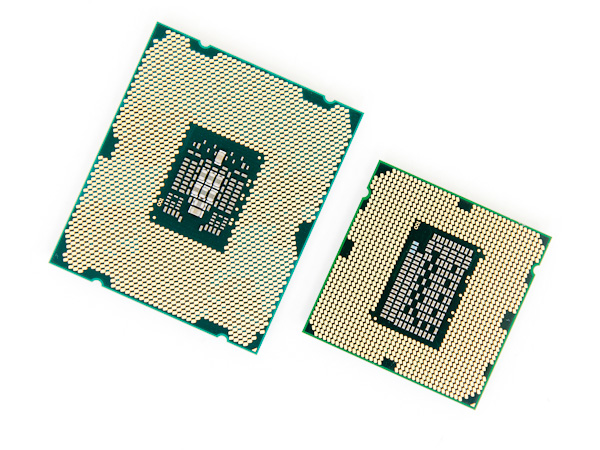
LGA-2011 SNB-E (left) vs. LGA-1155 SNB (right)
Sandy Bridge E is a fairly niche platform to begin with, but what about the niche within the niche (extremeception?) of users who just need the LGA-2011 platform but not necessarily a 6-core behemoth? For those users, there's the Core i7 3820:
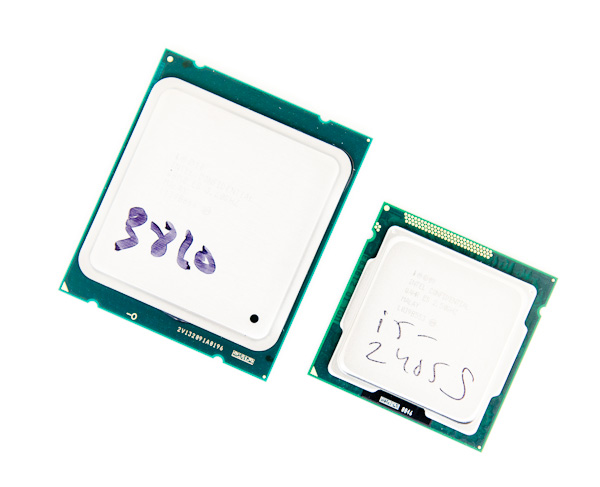
LGA-2011 SNB-E (left) vs. LGA-1155 SNB (right)
The Core i7 3820 is the first (and only) quad-core Sandy Bridge E CPU. It's so new that the chip isn't even available for sale nor will it be until early 2012. Unlike the relationship between the 3960X and 3930K, the 3820 is an entirely new die.
The chip features four Sandy Bridge cores and is paired with a 10MB L3 cache, giving it a slight advantage over the highest end LGA-1155 Sandy Bridge CPUs on the market today. The result is a die that's bigger than a regular SNB but significantly smaller than a 6-core SNB-E:
| CPU Specification Comparison | ||||||||
| CPU | Manufacturing Process | Cores | Transistor Count | Die Size | ||||
| AMD Bulldozer 8C | 32nm | 8 | 1.2B | 315mm2 | ||||
| AMD Thuban 6C | 45nm | 6 | 904M | 346mm2 | ||||
| AMD Deneb 4C | 45nm | 4 | 758M | 258mm2 | ||||
| Intel Gulftown 6C | 32nm | 6 | 1.17B | 240mm2 | ||||
| Intel Sandy Bridge E (6C) | 32nm | 6 | 2.27B | 435mm2 | ||||
| Intel Sandy Bridge E (4C) | 32nm | 4 | 1.27B | 294mm2 | ||||
| Intel Nehalem/Bloomfield 4C | 45nm | 4 | 731M | 263mm2 | ||||
| Intel Sandy Bridge 4C | 32nm | 4 | 995M | 216mm2 | ||||
| Intel Lynnfield 4C | 45nm | 4 | 774M | 296mm2 | ||||
| Intel Clarkdale 2C | 32nm | 2 | 384M | 81mm2 | ||||
| Intel Sandy Bridge 2C (GT1) | 32nm | 2 | 504M | 131mm2 | ||||
| Intel Sandy Bridge 2C (GT2) | 32nm | 2 | 624M | 149mm2 | ||||
There's a small improvement in base clock frequency over the fastest SNB (3.6GHz vs. 3.5GHz) but max turbo remains unchanged at 3.9GHz. For single threaded applications the 3820 should be just as fast as a Core i7 2700K or a 3960X. The same is true for if all heavily threaded workloads, at least when compared to other quad-core parts (the 3960/3930 still maintain an advantage because of their two additional cores).
| Processor | Core Clock | Cores / Threads | L3 Cache | Max Turbo | Max Overclock Multiplier | TDP | Price |
| Intel Core i7 3960X | 3.3GHz | 6 / 12 | 15MB | 3.9GHz | 57x | 130W | $990 |
| Intel Core i7 3930K | 3.2GHz | 6 / 12 | 12MB | 3.8GHz | 57x | 130W | $555 |
| Intel Core i7 3820 | 3.6GHz | 4 / 8 | 10MB | 3.9GHz | 43x | 130W | $285 |
| Intel Core i7 2700K | 3.5GHz | 4 / 8 | 8MB | 3.9GHz | 57x | 95W | $332 |
| Intel Core i7 2600K | 3.4GHz | 4 / 8 | 8MB | 3.8GHz | 57x | 95W | $317 |
| Intel Core i7 2600 | 3.4GHz | 4 / 8 | 8MB | 3.8GHz | 42x | 95W | $294 |
| Intel Core i5 2500K | 3.3GHz | 4 / 4 | 6MB | 3.7GHz | 57x | 95W | $216 |
| Intel Core i5 2500 | 3.3GHz | 4 / 4 | 6MB | 3.7GHz | 41x | 95W | $205 |
There's no on-die GPU, no heatsink/fan in the box and this isn't a fully unlocked part so the 3820 is actually cheaper than most of the high-end Sandy Bridge CPUs: it's priced at $285. If it weren't for the fact that you'll still need to spend over $200 on a motherboard I would say that the 3820 is a steal.
Overclocking
Let's start with the basics. All Sandy Bridge CPUs are clock locked by default, they can't operate at frequencies other than what they're sold at. There are two exceptions to this rule. All Sandy Bridge CPUs that support Turbo Boost are partially unlocked. Not only can they turbo up to frequencies that are higher than their default clock, but they can also be overclocked to frequencies even higher than their turbo speeds. By default, all Turbo enabled Sandy Bridge CPUs can be set to run at up to four bins (4 * bclk or 400MHz by default) higher than their standard turbo frequencies:
The second exception is any of the K or X-series SKUs. If your Sandy Bridge model number ends in a K or X, then the chip is fully unlocked and can be overclocked up to 5.7GHz using only clock multiplier adjustments.
The Core i7 3960X and 3930K fall into the latter category, which makes overclocking them a breeze. The 3820 on the other hand is partially unlocked, which means that we can run it at up to 4.3GHz using multiplier adjustments alone. Note that the 4.3GHz limit only applies to the 1-core active state, in the worst case scenario of all cores active with no room to turbo the highest operating frequency of the chip when overclocked would be 4.0GHz.
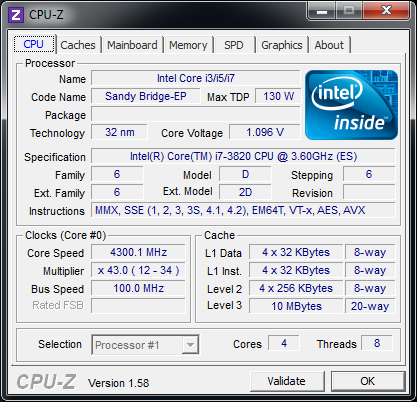
The max 3820 overclock without touching bclk settings
While these aren't bad targets, they're not all that exciting either. Thankfully Sandy Bridge E makes it even easier to overclock through the use of a few higher bclk frequencies. By default Sandy Bridge uses a 100MHz bclk, but SNB-E allows for 125MHz, 166MHz and 250MHz options as well. The 166/250MHz settings are a bit too aggressive, but the 125MHz bclk setting proved to be the perfect companion for the 3820.
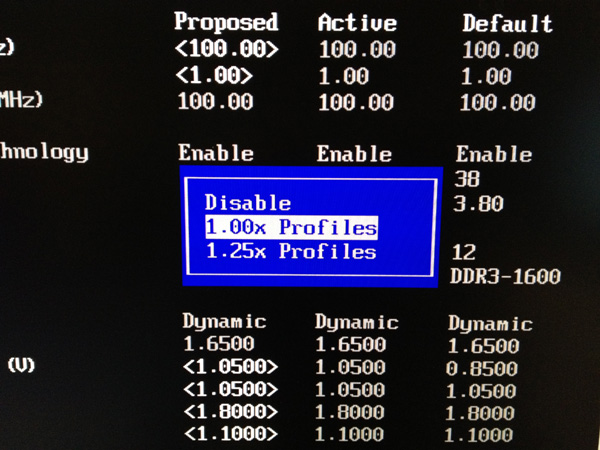
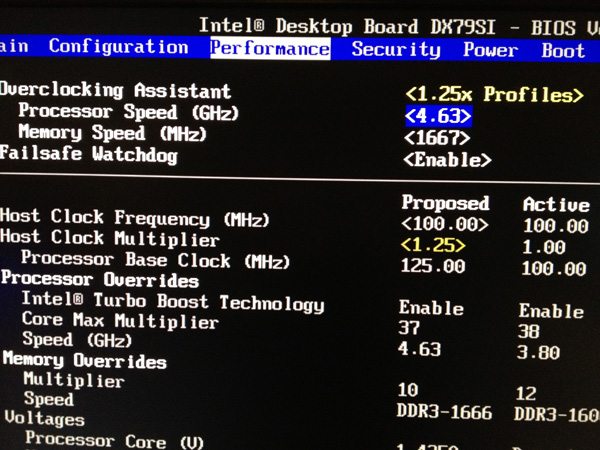
Intel's DX79SI makes it extremely easy to overclock, especially with the latest BIOS update. There are built in overclocking profiles for each bclk setting that you can choose from. I simply selected the 1.25x (125MHz) profile option and then went through the list of target frequencies until I found one that seemed promising. I also went in and tweaked some of the settings myself to get a bit more clock speed (4.63GHz is the fastest profile this board allows by default) and improve stability. In the end I was fairly pleased with what the 3820 could do: 4.75GHz with Intel's RTS2011LC closed loop cooling system.
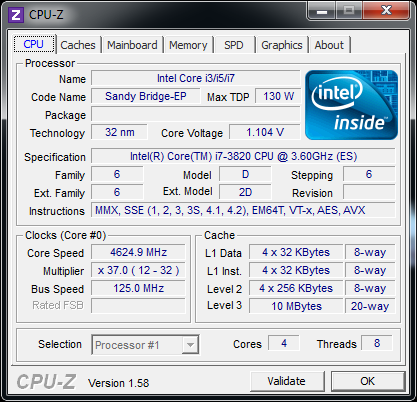
Now we're talking
I couldn't get the 3820 as stable as I would like at 4.88GHz and 5GHz was unfortunately out of the reach of my sample. I can't really complain about 4.75GHz from a $285 chip though, especially without resorting to anything too exotic from a cooling standpoint. Overclocking is also extremely effortless thanks to the new bclk options on SNB-E. Although the Core i7 3820 isn't an unlocked part, that doesn't limit how far (or how easily) it can be overclocked. A big part of the ease of overclocking is due to how good of a job Intel did on the DX79SI BIOS options, but from what we've seen the third party boards also do a decent job of simplifying the process.
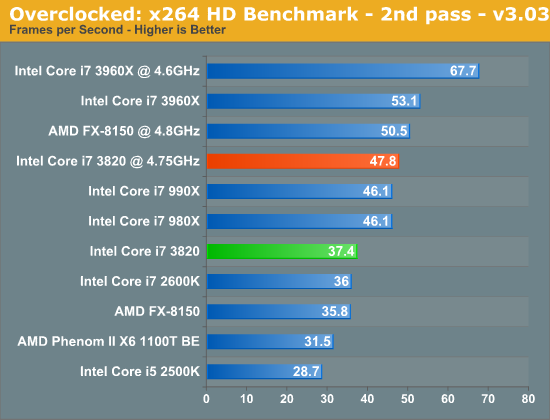
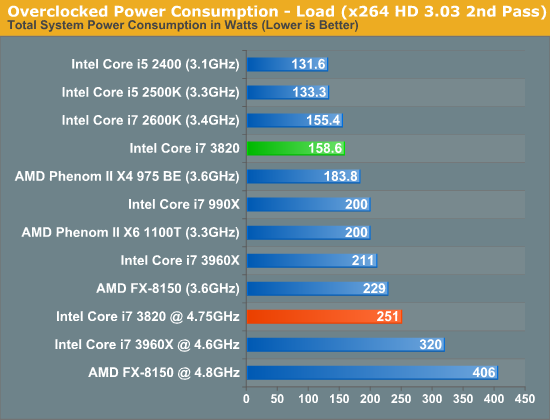
The Test
To keep the review length manageable we're presenting a subset of our results here. For all benchmark results and even more comparisons be sure to use our performance comparison tool: Bench.
| Motherboard: |
ASUS P8Z68-V Pro (Intel Z68) ASUS Crosshair V Formula (AMD 990FX) Intel DX79SI (Intel X79) |
| Hard Disk: |
Intel X25-M SSD (80GB) Crucial RealSSD C300 |
| Memory: | 4 x 4GB G.Skill Ripjaws X DDR3-1600 9-9-9-20 |
| Video Card: | ATI Radeon HD 5870 (Windows 7) |
| Video Drivers: | AMD Catalyst 11.10 Beta (Windows 7) |
| Desktop Resolution: | 1920 x 1200 |
| OS: | Windows 7 x64 |


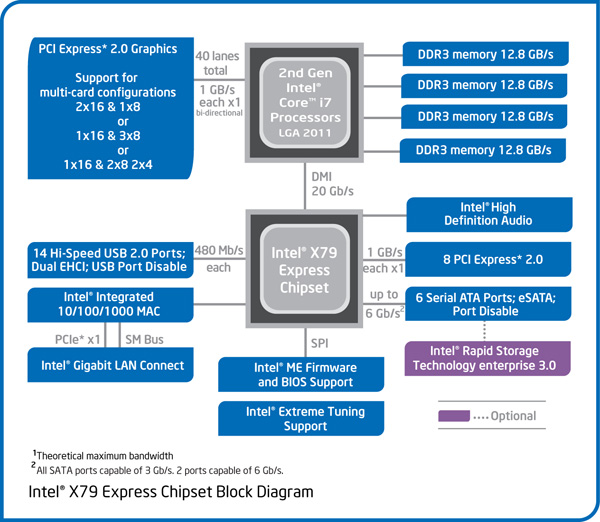









84 Comments
View All Comments
Hrel - Thursday, December 29, 2011 - link
So, shouldn't there be a price cut coming on 2700k, 2600k and other similar CPU's? If not Intel is being a dick again.SlyNine - Thursday, December 29, 2011 - link
Well no, There is no quick synk ( I believe) no IGP. it should be a cheaper chip.SlyNine - Thursday, December 29, 2011 - link
Without a IGP I guess there couldn't be quick synk. So forget the (I believe) partTetracycloide - Thursday, December 29, 2011 - link
So they're adding an IGP most users of the k series CPUs don't want, need, or use, charging them for it, and that means no, they're not a dick? I'm not following. I mean if this is really the reason to keep the current pricing on those SKUs then there's really no other option: Intel is being a dick again.Tetracycloide - Thursday, December 29, 2011 - link
Well, in fairness to Intel they're being a dick by offering this product at a pretty astonishingly low price for what's on offer which just makes their other SKUs look overpriced by comparison.SlyNine - Thursday, December 29, 2011 - link
How so, many people want Quick synk which REQUIRES the IGP. So explain how Intel is being a dick?Besides, Like there is a way for Intel to remove the IGP. Be practical or go home.
SaltwaterC - Wednesday, January 4, 2012 - link
Food for thought ... http://ark.intel.com/compare/52213,52276,52277,522...chizow - Thursday, December 29, 2011 - link
I haven't followed SB-E that closely but I figured the 4-core derivative would be a badly cut down (reject) version of the 8-core chip, basically the dregs of the wafer basically cut down to half usable.Can't believe they went with an entirely new die that still benefits from the greater 2.5MB L3 amount per core. It should actually perform better than the 3930K in cases that use 4 cores or less.....amazing. Intel couldn't have made this chip only to become a $280 desktop part....are they planning to use it for their low-end servers as well?
This also really provides that budget friendly high-end part for X79, basically the successor to the i7-920 for entry level enthusiasts. X79 still has its glaring omissions (USB 3.0, limited SATA6G, no Thunderbolt etc) but the 3820 makes it look better compared to SB and even IB.
$285 is an amazing price point.....I fully expect to see it for $199 at Micro Center a month from now. :) I wonder if there will be a K edition.....
Kevin G - Thursday, December 29, 2011 - link
I was figuring that the 4 core version was a cut down 8 core version too. I suspect that there will still be some of the 8 core dies being sold at 4 core just to get rid of inventory (OEM only parts perhaps?).I figure the reason for a native 4 core die is so that they can lower power consumption even further. Even with a completely disabled core, there is still some additional power consumption due to the internal ring bus. Speaking of which, I wonder if the reduction in hops in the internal ring bus will have any noticeable impact on performance anywhere (lower L3 cache latencies ect?).
The other reason for a native 4 core die is likely for high clock speed or ultra low power Xeon parts. There is a little known 4.4 Ghz dual core Xeon for socket 1366. It wouldn't surprise me if all the chips that test for high clock speeds are binned for a similar Xeon and not Core i7 3820's. :(
Though if we're lucky many of the X79 motherboards will work with the socket 2011 Xeon's.
Denithor - Thursday, December 29, 2011 - link
Low end servers would be my guess as well. All that memory bandwidth, PCIe lanes, perfect for applications where massive quantities of RAM (along with high speed access to it) is more important than raw cpu power.Seems like they ran an article on Facebook's server farms where FB uses AMD systems for RAM caching even though the cpu performance was much, much lower in the same power envelop simply because the AMD systems had more RAM sockets. This would seem like a direct replacement for those kind of systems.